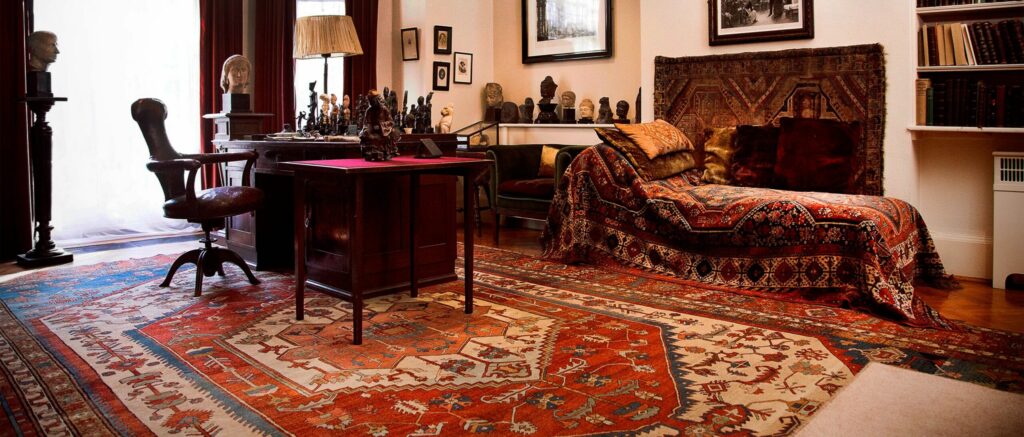Sigmund Freud’s Persian Rug, If you have a hack for psychology, you surely have heard Sigmund Freud’s name, the father of psychoanalysis. His exceptional intelligence and efforts shaped the foundation of modern psychology. Freud invented a pioneering method to diagnose. He also treated psychological issues in a clinical manner via an intimate and friendly dialogue between the patient and the psychiatrist.
Not only his ground-breaking theories and methods but also the design of his working room formed the way we see our therapists today. He came up with the quite useful idea of providing a 100% comfortable place for the patient to help them pour out their probably annoying thoughts.
He used a soft and cozy couch with so many cushions with a warm and eye-catching Persian rug on top. In this article, we are going to tell you about how the Persian rugs made their way to the world of the preeminent Sigmund Freud.
Freud’s Personal and Career Life

Sigmund Freud was born in an Austrian Jewish family in 1856. From an early age, he demonstrated significant intelligence and passion. Surprisingly, he entered the University of Vienna at the age of just 17 to study medicine. Among all the medicine majors, neurology and its correlation with the human psyche stole Freud’s attention.
After graduating, he began working at the Vienna Hospital. There, he focused on the human’s unconscious mind via recalling the forgotten traumatic memories by hypnosis.
Visiting a Friend instead of the Doctor
The more he studied and analyzed the patients, the more he realized that psychological issues are as important as physical ones. So they must be treated clinically, and face-to-face speaking to an expert psychiatrist is the best way to treat the patient.
In order to provide a suitable platform for the dialogue, he decided to visit the patient at his home, just like how he meets his friends and family. He dedicated a room in the house for that and tried to make it as comfortable as possible.
He put the so-called clinic design completely aside and used his study room with quite a cozy design. So the patient wouldn’t feel they are visiting a doctor in the clinic. Instead, they have an intimate chat with a friend in his lively study room. The centerpiece of this room was a large couch which was a present from one of his patients, Madame Bevenisti.
Freud’s Passion for Persian Rugs

He filled the couch with plush cushions with an impressively elaborate and soft Persian Qashqai rug. He had bought from a dealer with the help of his brother-in-law, Moritz Freud.
This Oriental Rug was made by sheepherder tribes in the Fars province in the south of Iran. The diamond-shaped pattern along with the floral motifs was actually a metaphor for his own job. After that, Persian Rugs became Freud’s other source of passion. So he began collecting them to decorate his study room where he met patients.
Freud’s Rugs as his fellow Travelers
With the Nazis gaining power in Germany and then annexing Austria to the Reich, the extremely anti-semitic agenda of the Nazis became a nightmare for Freud and his family, who had a Jewish background.
That’s why in 1939, Freud said Auf Wiedersehen to his home town Vienna and took refuge in London with his family. His famous couch and rugs accompanied him in this journey as well. So he could recreate his study room again exactly the way it was back in Vienna.
In London, Freud kept on creating the path of psychoanalysis with brand-new theories, practical methods, and astounding results with patients. In 1939, he passed away after a long battle with cancer.
His house in Maresfield Gardens has now turned into a museum, showing his lifelong research and studies. Interestingly, his famous rug-covered couch and his exquisite private collection of 20 rugs are on exhibit there as well.
Sigmund Freud was an exceptional scientist who made pioneering achievements in answering the question which was formerly only justified by superstitions. The modern method of psychoanalysis and his great taste in art will remain as his remarkable legacies.

